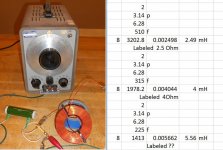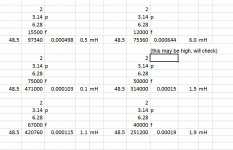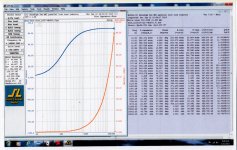i agree. It is basic AC theory. Im still a basic person.
I see it as this:
Z = R+jX
So id just measure Z at a convenient frequency measuring mV across a shunt, say 10 Ohm, volts from the joint of coil and amp to ground. Measure DCR. Textbook stuff. Set volts, measure mV across shunt to get mA.
Accurate enough i think.
I use it for rotor impedance tests at work regularly
My DMM was cheap, £20. It measures to 400hz to a fraction of a percent. Thats plenty high enough, unless youre making 0.001 uH coils...
I can't say that I understand your method of measuring inductance and how, if so, you could measure say 0.1 mH inductance at a frequency not more than 400 Hz.
But using ODougbo's method, the frequency range for measuring 0.5 mH to 10 mH is 2,500 Hz to 125 Hz. See the chart that he attached to his post #10.
By the way, in ODougbo's chart, I believe that the frequencies that he shows corresponding to 8 Ohm impedance of the inductor are too high by a factor of ten. In making my comment about a suitable voltmeter, I was accepting the range of frequencies in his chart. But anyway, in measuring 0.5 mH with his method, that frequency of 2,500 Hz is a bit high for most of the common AC voltmeters.
Regards,
Pete
The neat thing about changing the frequency so the voltage measures the same across the resistor as across the inductor is that (once they are measured as equal) the frequency is the same for both measurements, and it doesn't matter how inaccurate the voltmeter is at that frequency. It only needs to give a varying response to a varying amplitude.
Pete,
my
I just switched to the 8ohm load not long ago, maybe the 43.0ohm was the better choice.
In the past I always double checked everything - the thin board shown has 10 "factory" inductors - 1.0 - going smaller. I have a bunch of "subwoofers" coils, steel lam. etc.
Point being, I never had any issues with volt meter or readings.
I'll will go back and check some of the bigger coils. (might have 6.0s, but laying on work bench at work)
Thanks!
my

I just switched to the 8ohm load not long ago, maybe the 43.0ohm was the better choice.
In the past I always double checked everything - the thin board shown has 10 "factory" inductors - 1.0 - going smaller. I have a bunch of "subwoofers" coils, steel lam. etc.
Point being, I never had any issues with volt meter or readings.
I'll will go back and check some of the bigger coils. (might have 6.0s, but laying on work bench at work)
Thanks!
I can't say that I understand your method of measuring inductance and how, if so, you could measure say 0.1 mH inductance at a frequency not more than 400 Hz.
But using ODougbo's method, the frequency range for measuring 0.5 mH to 10 mH is 2,500 Hz to 125 Hz. See the chart that he attached to his post #10.
By the way, in ODougbo's chart, I believe that the frequencies that he shows corresponding to 8 Ohm impedance of the inductor are too high by a factor of ten. In making my comment about a suitable voltmeter, I was accepting the range of frequencies in his chart. But anyway, in measuring 0.5 mH with his method, that frequency of 2,500 Hz is a bit high for most of the common AC voltmeters.
Regards,
Pete
Okay - checked what I had here - "factory coils"
2.5ohm
4.0ohm
and a super large unknown - shown
not bad.
Now those calculations jive.
What benb in his post #22 says and I said earlier is that voltmeter accuracy IS NOT an issue with the method for measuring inductance that you are using.
Measuring with a 43 Ohm series resistor might not be a bad idea, as audio amps find a load with a phase angle of greater than 40 degrees to be "difficult". Using the 43 Ohm resistor, you would be significantly reducing power output of the amp, relative to using an 8 Ohm series resistor.
On the downside with a 43 Ohm resistor, if you were trying to make an inductor of 0.1 mH, your test frequency would be 67 kHz, well above the high frequency that most amps will amplify.
Regards,
Pete
Im an engineer Jim, dammit! Im not a mathematician!
as Pete bluntly points out, with an R so large you have issues. The method i use works for large-ish values, if i want a 0.1mH or smaller ill buy. Its not economical. Saying that i wound a 47uH coil, took it to work and used a bridge to measure and tune. If i didnt have that facility then id just buy. Must say im surprised Pete doesnt understand my method...its been in use for decades and its in the IEC60034 certs somewhere. To sum it up you find the -3db point (halfpower point), extropolate inductance. i think. Im still learning. There is a touch of the artist in me also
as Pete bluntly points out, with an R so large you have issues. The method i use works for large-ish values, if i want a 0.1mH or smaller ill buy. Its not economical. Saying that i wound a 47uH coil, took it to work and used a bridge to measure and tune. If i didnt have that facility then id just buy. Must say im surprised Pete doesnt understand my method...its been in use for decades and its in the IEC60034 certs somewhere. To sum it up you find the -3db point (halfpower point), extropolate inductance. i think. Im still learning. There is a touch of the artist in me also
Last edited:
If you've Googled, you may have found this "A Simple Procedure for Measuring Inductance" page.
Additionally, for this circuit (as shown in the link) total impedance Zt is equivalent to the hypotenuse of a right triangle with XL and R representing the other two sides... so Zt = √(XL^2 + R^2). I'm sure I learned that in the past, and am now not as likely to forget it again.
Additionally, for this circuit (as shown in the link) total impedance Zt is equivalent to the hypotenuse of a right triangle with XL and R representing the other two sides... so Zt = √(XL^2 + R^2). I'm sure I learned that in the past, and am now not as likely to forget it again.
Last attempt! Tried a 100ohm resistor - similar untrustworthy results.
I'm guessing a 50ohm would be the best, however double check with "Factory Coils" and/or extrapolate the size needed.
The trap method seems to work very well to duplicate a coil, down to a turn or two of wire.
I'm guessing a 50ohm would be the best, however double check with "Factory Coils" and/or extrapolate the size needed.
The trap method seems to work very well to duplicate a coil, down to a turn or two of wire.
lol. I still think its simples to measure DCR and subtract that from a measured Z at a conveniant frequency, then subbing into reactance Eq to find L. checked works test set up and no cap in circuit. Im not sure why a more involved method is required to be totally honest.
Mod: could u pls remove my post no.28? Got befuddled by critics and ended up talking out my rear
Mod: could u pls remove my post no.28? Got befuddled by critics and ended up talking out my rear
Last edited:
mondo, just a little over my head 
However, did go back and make up a new resistor pack with 6 - 8 ohm resistors.
Results were much better, and constant. The 6mH is the only one in question, looks like 6.5mH.
Extra credit if somebody can tell me why the coil starts singing at the measured frequency?
btw, I did order meter - VC6243.

However, did go back and make up a new resistor pack with 6 - 8 ohm resistors.
Results were much better, and constant. The 6mH is the only one in question, looks like 6.5mH.
Extra credit if somebody can tell me why the coil starts singing at the measured frequency?
btw, I did order meter - VC6243.
Attachments
For you builders who might have woofer testers, you can use them to measure inductors (and caps) very accurately with proper calibration.
Below is an example using the original WT2 tester. That coil was taken from a Paradigm 3se MkI xover.
Below is an example using the original WT2 tester. That coil was taken from a Paradigm 3se MkI xover.
Attachments
- Status
- This old topic is closed. If you want to reopen this topic, contact a moderator using the "Report Post" button.
- Home
- Loudspeakers
- Multi-Way
- Help - Forgot how to measure coils



